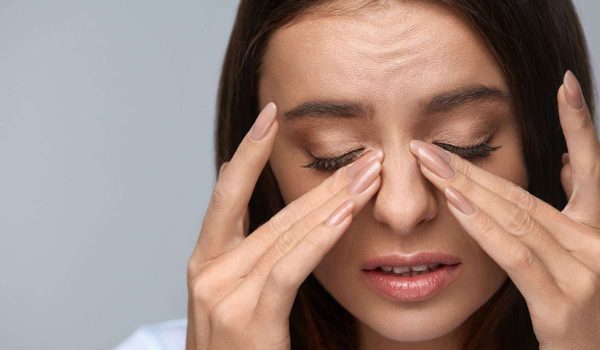
تُعتبر العين هي نافذتنا للعالم الخارجي، فبها نستطيع التعرف على كل ما يحيط بنا، وعلى قدر أهميتها إلا أنها واحدة من المناطق الأكثر حساسية بالجسم والأكثر عرضة للمشكلات المختلفة. فقد تذهب للنوم دون وجود أي مشكلة، ثم تستيقظ وأنت تشعر بوجود تورم مفاجيء بالعين مما يدفعك للتساؤل عن سبب هذا التورم. في هذا المقال ستتعرف على أهم أسباب تورم العين المفاجئ وكذلك طرق العلاج، لذا تابعنا عزيزي القاريء.
اسباب تورم جفن العين المفاجئ
يمكن أن يحدث تورم العين لعدد من الأسباب من بينها تكون السوائل في الأنسجة الرقيقة المحيطة بالعين، وبالتالي يمكن أن تتورم العين والجفون كذلك. وهناك العديد من الأسباب التي قد تؤديء لحدوث الأمر، وسأعرض بعض الأسباب في الأسطر القليلة القادمة:
- الحساسية، تعتبر الحساسية من المشكلات الشائعة والأسهل في العلاج، والتي قد تنتج عن حمى القش أو الحساسية تجاه الطعام، أو الحساسية تجاه الكيماويات.
- الإرهاق، يمكن أن يتسبب في تورم العين بسبب تجمع السوائل طوال الليل، وبالتالي قد يؤثر على جفن العين ويؤدي لتورمه.
- البكاء، يمكن أن يتسبب البكاء في تمزق الأوعية الدموية الدقيقة في جفن العين، وبالتالي تجمع السوائل في الجفن وحدوث تورم للعين.
- مستحضرات التجميل، يمكن أن تتسبب مستحضرات التجميل التي تدخل إلى العين في حدوث تهيج للعين والمنطقة المحيطة، وبالتالي حدوث تورم واحمرار في العين.
- هربس العين، وهو عبارة عن عدوى في المنطقة المحيطة بالعين، ويمكن أن يصاب به الجميع، لكنه شائع بصورة أكبر بين الأطفال، وقد يبدو مشابه لمرض العين الحمراء، ولكنه لا يتسبب في ظهور الآفات في منطقة العين.
- التهاب الجفن، يمكن أن يحدث بسبب تجمع البكتيريا داخل العين وفي المنطقة المحيطة بها. وقد تظهر بعض الأعراض بالإضافة لتورم العين، مثل وجود جفون زيتية، وقشور على الرموش.
- انسداد القنوات الدمعية، عند حدوث انسداد في قنوات الدموع، تتجمع الدموع بحيث لا تقدر العين على تفريغها، فيحدث انتفاخ في جفن العين. والمواليد الجدد هم الأكثر عرضة للإصابة به.
- التهاب الملتحمة، ويعرف باسم العين الحمراء، وتُعتبر هذه العدوى شائعة أثناء نزلات البرد، والأنفلونزا. وعادة ما يحدث الأمر نتيجة الإصابة بالفيروسات، والبكتيريا، وبعض المهيجات الأخرى.
- دمل العين، وهو عبارة عن عدوى في بصيلات الرموش أو الغدد الدمعية، ويظهر كنتوءات حمراء منتفخة على حافة جفن العين.
- خراج العين، ويكون مشابه لدمل العين وهو غير ضار، وهو عبارة عن نتوء صغير يظهر على جفن العين، كما يمكن أن يحدث بسبب انسداد الغدد الدهنية.
- الإصابات، عندما تقوم قوة بالضغط على العين، يحدث تجمع للدم تحت المنطقة المتضررة في العين. وهذا قد يتسبب في حدوث تورم وتغير في اللون.
- التهاب الهلل المحجري، وهو عبارة عن التهاب ينتشر من الجيوب الأنفة، وعادة ما يحدث لدى الأطفال بصورة أكبر من البالغين.
- مرض جريفز، وهو عبارة عن مرض مناعي ذاتي، يتسبب في حدوث التهابات في العين، ويرتبط بوجود مشكلات ف الغدة الدرقية.
- سرطان العين، يعتبر من الحالات النادرة والتي تسبب تورم العين أو المنطقة المحيطة بها، ولكن تورم العين واحد من أعراضه، ولكن تصاحبه بعض الأعراض الأخرى، مثل تشوش الرؤية، وفقدان الرؤية، أو رؤية مناطق داكنة في مجال الرؤية.
طرق علاج تورم العين المفاجئ
عليك أن تعلم عزيزي القاريء أن تورم العين عادة ما يختفي خلال عدة أيام، لكن بإمكانك اتباع عدد من الخطوات التي قد تساعد في تقليل التورم، ومن الخطوات التي يمكن اتباعها:
- غسل العين، يمكن غسل العين بالماء البارد من أجل تقليل التورم في حالة الحساسية.
- وضع الكمادات الباردة، يساعد وضع الكمادت الباردة في تخفيف التورم في الحالات الناتجة عن الإرهاق والبكاء.
- قطرات العين التي تحتوي على مضادات الهيستامين، والتي تستخدم من أجل علاج الحساسية، ولكن لا يجب استخدامها إلا بنصيحة الطبيب.
- التخلص من العدسات اللاصقة، في حالة كنت تقوم بارتداء العدسات اللاصقة، يجب التخلص منهم على الفور في حالة حدوث تورم.
ويجب عليك أن تعلم عزيزي القاريء أن طرق العلاج السابقة يتم استخدامها في حالات التورم الخفيفة، ولكن في حالة استمرار التورم لأكثر من 24 : 48 ساعة، فسيكون عليك الاتصال بالطبيب، حيث أن هناك بعض الحالات التي تستدعي زيارة الطبيب.
ويجب عليك الاتصال بالطبيب في حالة ظهور أي من العلامات التالية:
- ألم في العين.
- تشوش الرؤية.
- ضعف النظر.
- الشعور بوجود شيء في العين.
العناية بالعين على المستوى الطويل
لتتأكد من صحة العين، فسيكون عليك فحص العين بصورة دورية سواء كان هناك تورم في منطقة العين أو لا. حيث يمكن أن يكشف الفحص عن وجود مشكلات مثل الجلوكوما، وهي من المشكلات التي تدمر العين ببطء.
ويمكن أن يساعد فحص العين في الكشف عن العديد من الأمراض، مثل:
ويجب أن تقوم بزيارة الطبيب كل فترة، فالأشخاص الذين تقل أعمارهم عن الـ 40 يمكنهم زيارة الطبيب كل أربع أو خمس سنوات. وبعد سن الـ 40 يجب الحرص على زيارة الطبيب كل سنتين أو ثلاث. والأشخاص بسن الـ 50 أو أكبر، يجب عليهم زيارة الطبيب سنوياً. ويساعد الفحص في الكشف عن الأمراض بصورة مبكرة، وبالتالي علاجها بصورة أفضل.
والآن عزيزي القاريء وبعد انتهائك من هذا المقال، ستكون قد تعرفت على أسباب تورم العين المفاجئ وطرق علاجه، وإذا شعرت أنك بحاجة لمزيد من الاستفسارات، يمكنك استشارة أحد أطبائنا من هنا.
